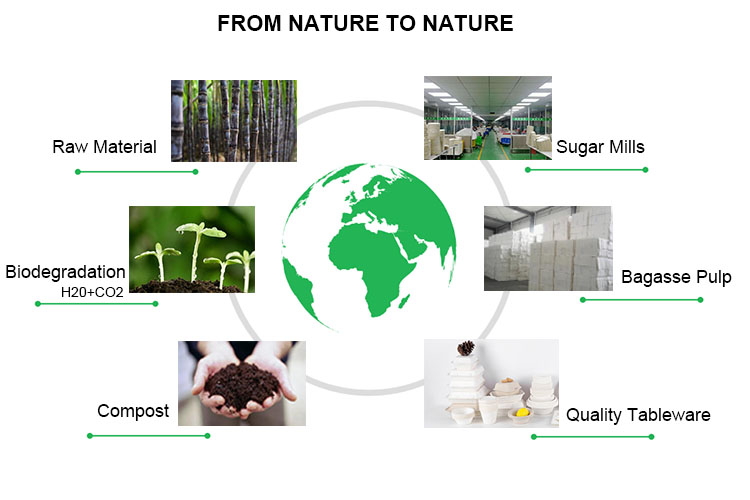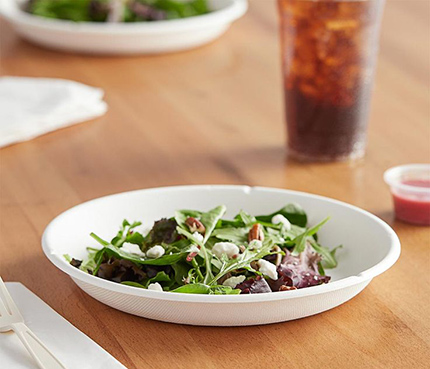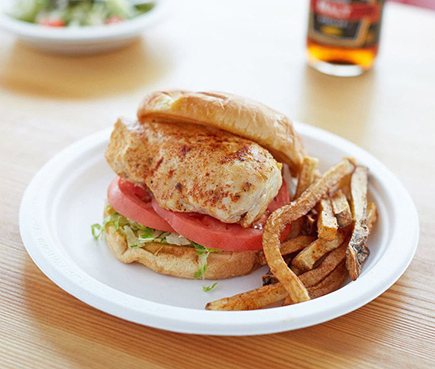Categorie
Nuovo blog
From Raw Material to Bagasse Plates: The Complete Manufacturing Process
May 29 , 2023
Discover the fascinating journey of sugarcane waste transformed into eco-friendly bagasse plates. In this blog post, we explore the complete manufacturing process, step by step, from raw material to the final product.
By understanding this intricate process, we gain insight into the sustainable production of bagasse plates, offering a greener alternative to plastic and foam. Join us on this journey of transformation and learn why sugarcane bagasse plates are the eco-conscious choice for food service and packaging.

Here is the detail step of manufacturing sugarcane bagasse plates in the factory:
Sugarcane is harvested by cutting down mature stalks either manually or with machinery. The stalks are then taken to a sugar mill where they go through crushing machines to extract the juice. The leftover fibrous residue, called bagasse, is collected and stored for further processing.
The collected bagasse undergoes a processing step to prepare it for plate production. Initially, the bagasse is washed to remove any impurities or debris. It is then subjected to a process of heat and pressure to remove excess moisture and lignin. Lignin is a natural binder found in the bagasse fibers that needs to be reduced to improve the quality of the final product. This process is commonly achieved by using steam or hot water, which softens the bagasse and helps in separating the fibers.
Once the bagasse is processed, it is transformed into pulp. There are two main methods for pulp formation: mechanical and chemical. In the mechanical method, the processed bagasse is mechanically beaten or refined to separate the fibers further. This results in a pulp-like consistency with individual fibers. In the chemical method, chemicals are used to break down the bagasse fibers, resulting in a finer pulp.
The bagasse pulp is then molded into plate-shaped forms using specialized machinery. The molding process involves placing the bagasse pulp into plate-shaped molds that define the size and shape of the final plates. The molds can be customized to produce plates of various sizes, thicknesses, and designs.
Once the bagasse pulp is molded into plates, the plates need to be dried. This can be achieved through different methods, such as heat drying or air drying. Heat drying involves using ovens or drying chambers where the plates are subjected to controlled heat until they are completely dry.
Air drying, on the other hand, involves placing the plates in well-ventilated areas where natural air circulation helps in evaporating the moisture. Additionally, pressing may be applied to enhance the plate's strength and density. This can involve using hydraulic presses or other mechanical means to compress the plates, making them more rigid and durable.
After the plates are dry, any excess material or rough edges are trimmed off to ensure uniformity in size and shape. Trimming can be done manually or using automated equipment.
Furthermore, the plates may undergo additional finishing processes to improve their appearance and performance. This can include polishing the surface to achieve a smoother texture or applying a food-grade coating to enhance water resistance and durability.
The final step involves packaging the finished bagasse plates. They are typically stacked and packed in appropriate containers, such as cardboard boxes or plastic wrapping, to protect them during transportation and storage. The packaging is often labeled with relevant information about the product, such as the size and quantity of plates contained within.
By following these detailed steps, bagasse plates are produced from sugarcane waste, providing an eco-friendly alternative to plastic or foam plates. Bagasse plates are biodegradable and made from a renewable resource, making them a sustainable choice for food service and packaging.

source: Pinterest
Sugarcane bagasse plates are a sustainable and versatile alternative to traditional disposable plates. Derived from sugarcane fibers, these plates offer unique properties and benefits that make them an excellent choice for environmentally conscious consumers.
Bagasse plates have unique properties and benefits. They are sturdy and durable, capable of holding heavy and saucy meals without compromising their structural integrity.
These plates exhibit heat and moisture resistance, allowing them to withstand high temperatures without warping or becoming soggy. They are also resistant to oil and water absorption, retaining their strength and shape even when used with greasy or moist food items.
Bagasse plates are microwave and freezer safe, offering convenience and versatility. They can be used to reheat food in the microwave and safely store leftovers and frozen meals without concerns about plate integrity.
Bagasse plates are eco-friendly and made from sugarcane fibers, a renewable resource. They are fully biodegradable and can be easily composted, reducing waste sent to landfills.
Unlike plastic or foam plates that take centuries to decompose, bagasse plates break down within a few months, contributing to a cleaner environment. Composting bagasse plates enriches the soil by releasing valuable nutrients, which can be used for sustainable agricultural practices and enhancing plant growth.
Bagasse plates are a more sustainable choice compared to plastic, foam, or paper plates. Plastic plates contribute to pollution and decompose over hundreds of years, while foam plates are non-biodegradable. Paper plates involve deforestation and require more resources to manufacture than bagasse plates.
In terms of performance, bagasse plates are sturdy, heat-resistant, moisture-resistant, and oil-resistant, making them suitable for various types of food. Unlike paper plates that can weaken when handling moist or greasy food, bagasse plates maintain their integrity throughout the meal.
Bagasse plates stand out as an eco-friendly and versatile alternative to conventional disposable plates. Their unique properties, such as sturdiness, heat and moisture resistance, and oil repellency, make them an excellent choice for serving various types of food.
Moreover, their biodegradability, compostability, and renewable nature contribute to a more sustainable future. By choosing bagasse plates, your business can make a positive impact on the environment while enjoying the convenience and performance they offer.

source: Pinterest
Bagasse plates offer significant environmental benefits compared to traditional disposable plates. As a byproduct of sugarcane processing, utilizing bagasse as a raw material helps reduce waste and effectively utilizes agricultural residues.
Sugarcane bagasse plates are fully biodegradable and compostable, breaking down naturally without persisting in the environment like plastic plates. By choosing bagasse plates, we can reduce plastic waste generation and minimize the negative impact of single-use plastics on ecosystems and human health.
Furthermore, bagasse plates contribute to the preservation of forests and ecosystems by reducing the demand for wood pulp obtained through deforestation.
By opting for sugarcane bagasse plates, consumers and businesses can make a tangible difference in reducing plastic waste, promoting sustainable resource management, and contributing to a healthier planet.

source: Google Image
Customization and branding options for sugarcane plates provide numerous benefits for businesses. By customizing the plates with company logos, designs, or branding, businesses can create a unique brand identity and make a lasting impression on customers. This customization allows for brand reinforcement and increased brand awareness.
The personalized packaging also plays a crucial role, as it showcases the company's logo, colors, and design elements, creating a cohesive and professional look. This helps retailers strengthen their brand presence and increase recognition among customers. Personalized packaging adds a premium touch, signaling careful craftsmanship and attention to detail. It also aids customers in identifying the brand and enhances the perceived value of the product.
The design and customization process involves collaborating with manufacturers to bring the vision to life, ensuring the desired result is achieved through the appropriate printing or embossing technique. This process not only creates visually appealing plates but also enhances brand visibility.
Customized bagasse plates act as tangible representations of the brand and generate word-of-mouth marketing. The unique design or branding on the plates sparks interest and inquiries, leading to increased visibility and potential new customers.
Overall, customization and branding options for bagasse plates contribute to brand differentiation, recognition, and success. You can contact Hefei Craft Tableware to custom your unique bagasse plates.

source: Pinterest
As a leading manufacturer of bagasse plates in China, we understand that you may have questions and concerns regarding these eco-friendly products. In this section, we aim to address some of the most common queries and provide comprehensive answers and explanations to alleviate any doubts or misconceptions.
Yes, bagasse plates are made from natural sugarcane byproduct and do not contain harmful chemicals or toxins. Bagasse plates are food-grade and meet safety standards set by regulatory authorities. Bagasse plates provide a safe and reliable option for serving food without compromising on health and hygiene.
Yes, bagasse plates can withstand hot and oily foods. They have excellent heat resistance properties and can handle temperatures up to a specified level. The natural fibers in bagasse plates provide strength and prevent them from becoming soggy or deforming when in contact with oil or liquids.
Bagasse plates are known for their durability and strength. Unlike flimsy paper plates that can easily tear or plastic plates that may crack or break, bagasse plates offer superior sturdiness. They are rigid and can hold a significant amount of food without bending or collapsing. Whether it's a casual gathering or a large event, bagasse plates provide reliable durability, ensuring that your customers' dining experience remains hassle-free.
From raw material to bagasse plates, the manufacturing process is a fascinating journey of transformation. By understanding this process, we gain insight into the sustainable production of eco-friendly bagasse plates, offering a greener alternative to plastic and foam.
Bagasse plates have unique properties and benefits, such as sturdiness, heat and moisture resistance, and oil repellency, making them suitable for various types of food. They are fully biodegradable and compostable, contributing to a cleaner environment. By choosing sugarcane bagasse plates, businesses can make a positive impact on the environment while enjoying the convenience and performance they offer.
Additionally, customization and branding options for bagasse plates provide businesses with the opportunity to create a unique brand identity and increase brand awareness. Choose Hefei Craft Tableware Co.,Ltd as your trusted supplier for customized bagasse plates and make a tangible difference in reducing plastic waste and promoting sustainability.